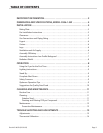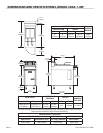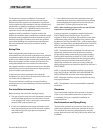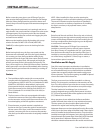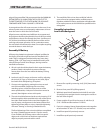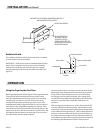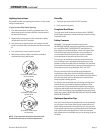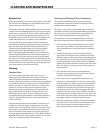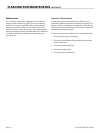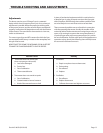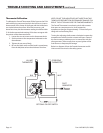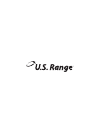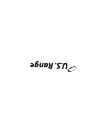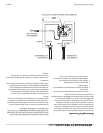
Part # 4518632 (02/19/08) Page 11
CLEANING AND MAINTENANCE
Routine Care
NEVER operate the burner with an empty frypot. It only takes
a few minutes to completely ruin a frypot this way, and the
frypot warranty is void if this is done.
The frying compound should be ltered at least once a day. If
a heavy volume of breaded food is fried, it may be necessary
to lter two or more times a day. This will increase the life of
the frying compound and produce better-tasting food. US
Range lter cones are ideal for this and are inexpensive and
readily obtainable from your dealer or parts distributor.
The fryer should be cleaned daily, and this operation can
be combined with ltering the frying compound. After the
fryer is drained, wipe the inside with cloth saturated in a
commercial fryer/griddle cleaner, then rinse thoroughly.
Wipe dry and put the ltered compound back in the
frypot. The frypot should be boiled out once a week with a
commercial fryer/griddle cleaner according to direction on
the bottle. Each day wipe down the controls and all inside
the door with a damp cloth. Remove the basket hanger and
clean at least once a week. This way your fryer will stay clean
and new looking much longer. Be sure that the grease cover
for the automatic gas valve is kept in place
Cleaning
Stainless Steel
For routine cleaning just wash with a hot water and
detergent solution. Wash just a small area at a time or the
water will evaporate leaving chemicals behind causing
streaking. Rinse the washed area with a clean sponge dipped
in a sanitizing solution and wipe dry with a soft clean cloth
before it can dry. Use a paste (of water and a mild scouring
powder) if you have to, but never rub against the grain.
All stainless steel has been polished in one direction. Rub
with the polish lines to preserve the original nish. Then
thoroughly rinse as before. To prevent ngerprints there
are several stainless steel polishes on the market that leave
an oily or waxy lm. Do not use on surfaces that will be in
contact with food.
Stainless steel may discolor if overheated. These stains can
usually be removed by vigorous rubbing with a scouring
powder paste. Use only stainless steel, wood or plastic tools
it necessary to scrape o heavy deposits of grease and oil.
Do not use ordinary steel scrapers or knives as particles of
iron may become imbedded and rust. STEEL WOOL SHOULD
NEVER BE USED. Either a typical bleach solution or hot water
can be use to sanitize stainless steel with harm.
Draining and Filtering Of Fryer Compound
The draining and ltering of fryer compound must be
accomplished with care to avoid the possibility of a burn
resulting from careless handling.
Filtering: Turn fryer o. Consult the ltering manufactures’
operation instructions for recommended ltering procedure.
Instructions for use of the lter Quick are included in the
Owners Manual shipped with your lter Quick unit.
The following is a recommended procedure to drain and
lter your compound when no lter machine is available:
1. Screw the drain pipe provided with your fryer into the
drain valve. Assure that you have rmly attached the
drain pipe and that the curved end portion is pointing
“down.”
2. Position the stock pot or other container under the
drain pipe. The stock pot or other container must be of
sucient design to withstand the heat generated by the
hot compound and must also be able to hold liquids. It is
recommended that where no lter machine is available,
the lter cone holder and lter cones be used. Be sure the
lter cone holder is resting securely on the stock pot or
other container.
3. Open the drain valve slowly to avoid splattering.
However, since splattering may occur anyway, extreme
caution should always be employed.
4. If the valve becomes clogged with food particles you
may wish to use a poker-like tool. The tool must be used
from the inside of the frypot only and caution should be
employed that the tool is gripped by the user as far as
possible from the hot fryer compound in the frypot. Do
not hammer on the drain valve as damage to the ball
inside the valve will cause it to leak. NEVER use this tool
or any other tool to unclog the valve from the front of the
valve. If the clog comes loose, hot compound could pour
out rapidly so beware of splattering in this event.
5. We recommend that the drained compound be allowed
to cool to 100°F or lower before transporting the stock
pot or other container, removing the drain pipe, or
removing the lter cone holder and lter cone.



